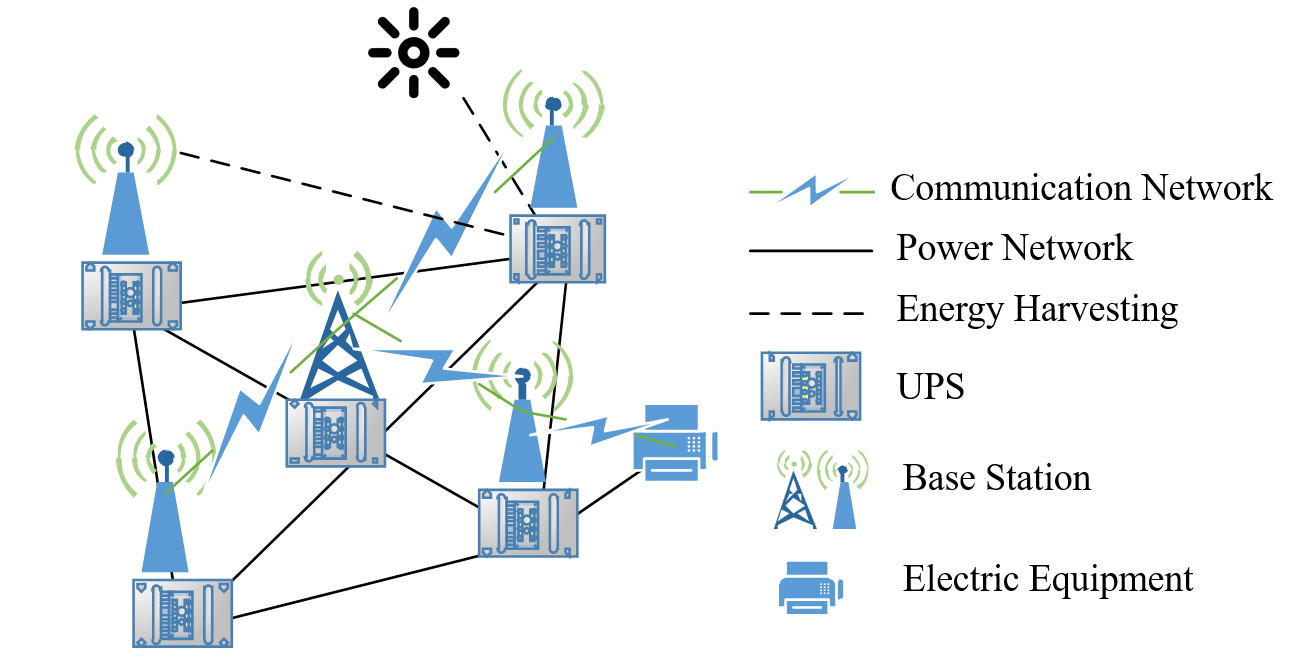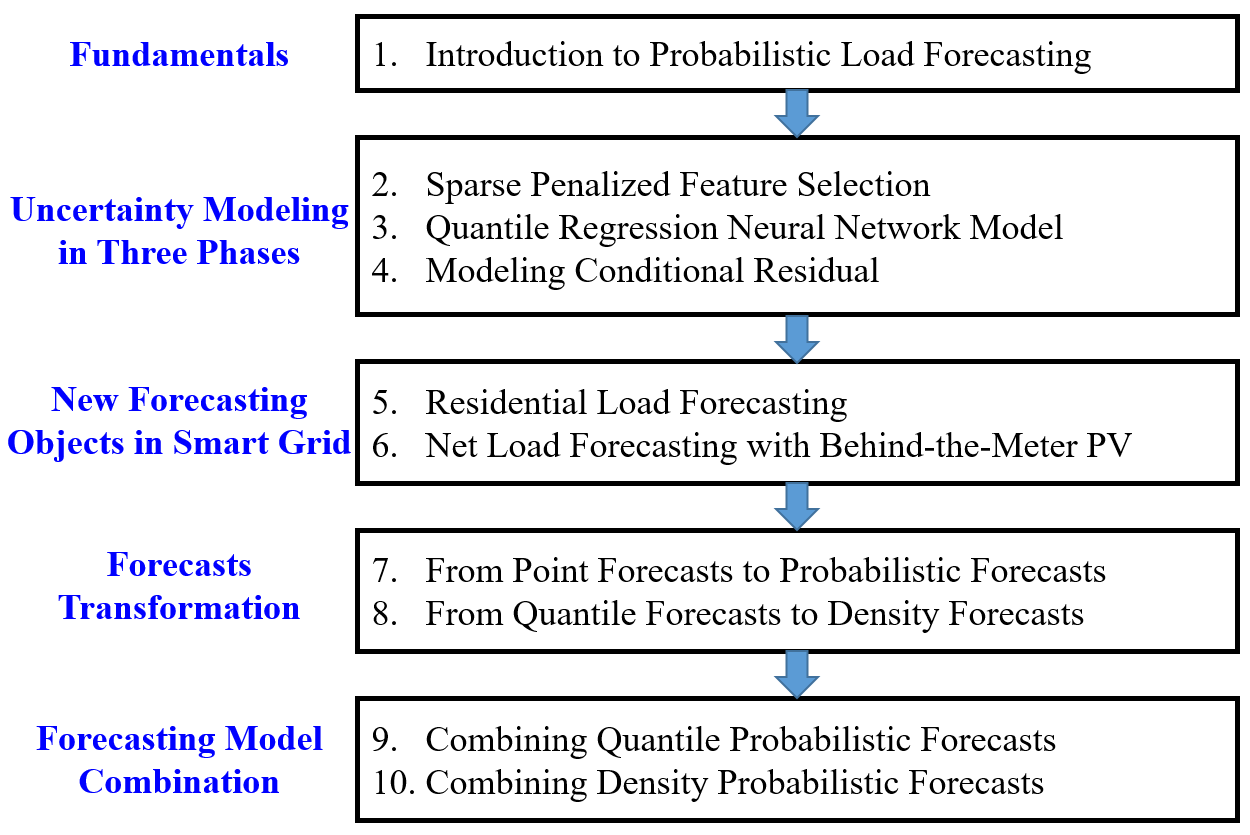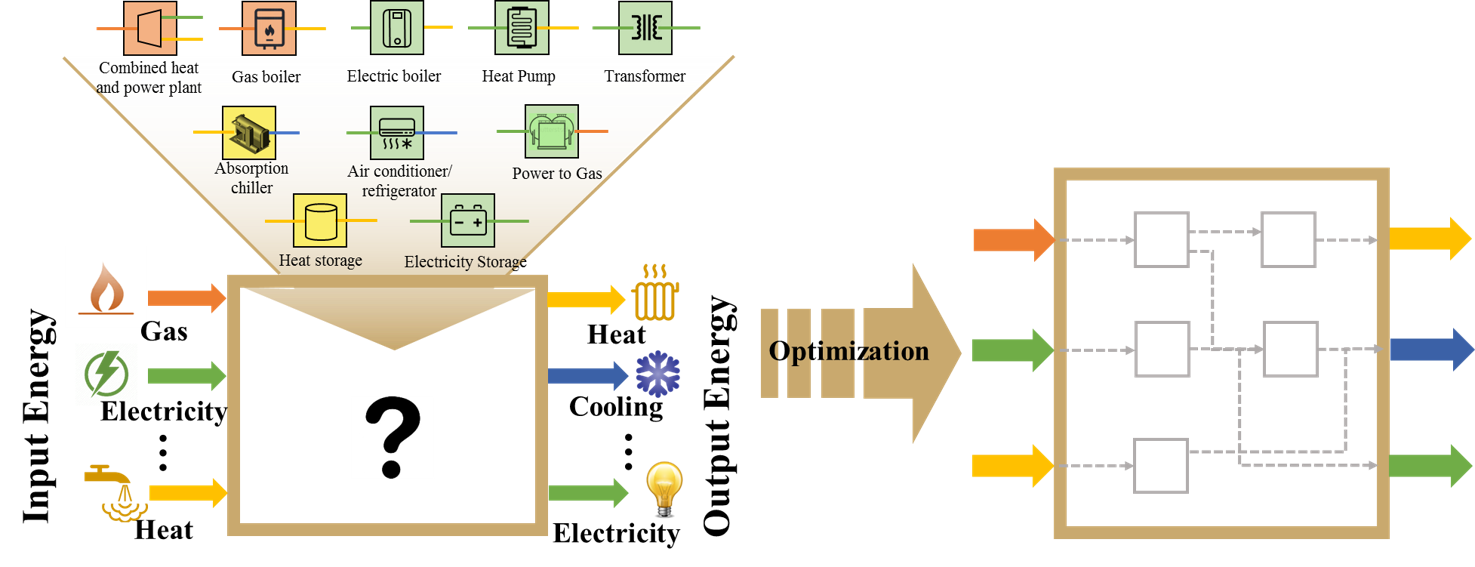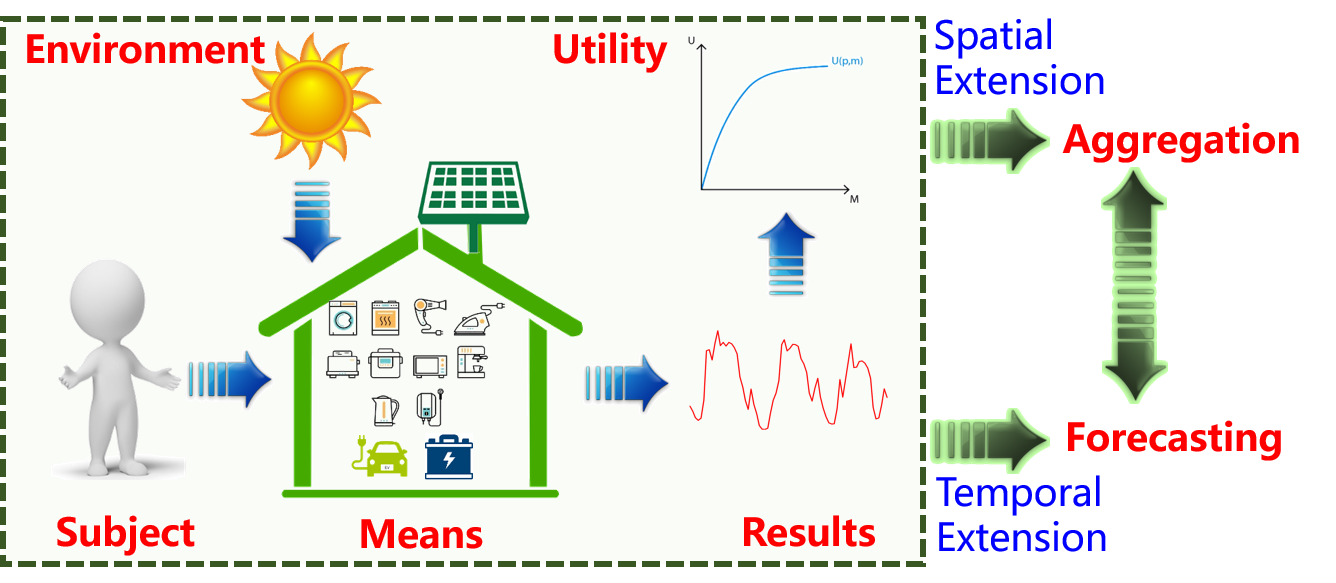Research Summary
My research interests can be divided into four main areas: wireless communication and power networks coupling, smart meter data analytics, probabilistic short-term load forecasting, and modeling and planning of multiple energy systems.
Wireless Communication and Power Networks Coupling
The ubiquitous electric Internet of Things (IoT) is a concrete manifestation of the IoT in the power industry. It is a deep integration of interconnected power network and communication network, and an important measure to implement the Energy Internet. The fifth generation mobile communication (5G communication) is favored by all walks of life because of its advantages of high bandwidth, low delay and low power consumption. It will also play an important role in the ubiquitous electric IoT. This paper discusses the deep fusion of the 5G communication technology and the ubiquitous electric IoT.
 |
Related Publications:
Yi Wang, Qixin Chen, Ning Zhang, Cheng Feng, Fei Teng, Mingyang Sun, Chongqing Kang, “Fusion of the 5G Communication and the Ubiquitous Electric Internet of Things: Application Analysis and Research Prospects,” Power System Technology, 2019, 43(5):1575-1585. (In Chinese)
Ning Zhang, Jingwei Yang, Yi Wang, Qixin Chen, Chongqing Kang, “5G Communication for Ubiquitous Power Internet of Things: Technical Principles and Typical Applications,” Proceedings of the CSEE, in press. (In Chinese)
Smart Meter Data Analytics
The widespread popularity of smart meters enables an immense amount of fine-grained electricity consumption data to be collected. Meanwhile, the deregulation of the power industry, particularly on the delivery side, has continuously been moving forward worldwide. How to employ massive smart meter data to promote and enhance the efficiency and sustainability of the power grid is a pressing issue. Following the three stages of analytics, namely, descriptive, predictive and prescriptive analytics, we identify the key application areas as load analysis, load forecasting, and load management. I try to adopt or develop advanced machine learning techniques and methodologies to address each application. In addition, we also discuss some research trends, such as big data issues, novel machine learning technologies, new business models, the transition of energy systems, and data privacy and security.
 |
Breakthroughs are needed to analyze the electrical consumer, where, combining physical-driven and data-driven approaches is an important trend. I decompose consumer behavior into five basic aspects from the sociological perspective: behavior subject, behavior environment, behavior means, behavior result, and behavior utility. On this basis, the concept of consumer behavior model is proposed. The data-driven modeling and analysis methods for consumer behavior are studied. A introduction slide can be found here
Related Publications:
Yi Wang, Qixin Chen, Tao Hong, and Chongqing Kang, “Review of Smart Meter Data Analytics: Applications, Methodologies, and Challenges,” IEEE Transactions on Smart Grid, in press.
Yi Wang, Qixin Chen, Dahua Gan, Jingwei Yang, Daniel Kirschen, and Chongqing Kang, “Deep Learning-Based Socio-demographic Information Identification from Smart Meter Data,” IEEE Transactions on Smart Grid, in press.
Kedi Zheng, Qixin Chen, Yi Wang, Chongqing Kang, and Qing Xia, “A Novel Combined Data-Driven Approach for Electricity Theft Detection,” IEEE Transactions on Industrial Informatics, in press.
Yi Wang, Qixin Chen, Mingyang Sun, Chongqing Kang and Qing Xia, “An Ensemble Forecasting Method for the Aggregated Load with Subprofiles,” IEEE Transactions on Smart Grid, 2018, 9(4): 3906-3908.
Chongqing Kang, Yi Wang, Yusheng Xue, Gang Mu, and Ruijin Liao, “Big Data Analytics in China's Electric Power Industry: Modern Information, Communication Technologies, and Millions of Smart Meters,” IEEE Power and Energy Magazine, 2018, 16(3): 54-65.
Yi Wang, Qixin Chen, Chongqing Kang, and Qing Xia, “Sparse and Redundant Representations-Based Smart Meter Data Compression and Pattern Extraction,” IEEE Transactions on Power Systems, 2017, 32(3): 2142-2151.
Dahua Gan, Yi Wang, Ning Zhang, and Wenjun Zhu, “Enhancing Short-term Probabilistic Residential Load Forecasting with Quantile Long-short-term Memory,” The Journal of Engineering, 2017, 2017(14): 2622-2627.
Yi Wang, Qixin Chen, Chongqing Kang, and Qing Xia, “Clustering of Electricity Consumption Behavior Dynamics Toward Big Data Applications,” IEEE Transactions on Smart Grid, 2016, 7(5): 2437-2447.
Wenjun Zhu, Yi Wang, Min Luo, Guoying Lin, Jiangnan Cheng, and Chongqing Kang, “A Distributed Clustering Algorithm Oriented Towards Awareness of Electricity Consumption Characteristics of Massive Consumer,” Automation of Electric Power Systems, 2016, 40(12):21-27. (In Chinese)
Yi Wang, Qixin Chen, Chongqing Kang, Mingming Zhang, Ke Wang, and Yun Zhao, “Load Profiling and Its Application to Demand Response: A Review,” Tsinghua Science and Technology, 2015, 20(2): 117-129.
Kedi Zheng, Yi Wang, Qixin Chen, et al., “Multidimensional Smart Meter Data Analytics based on Sparse Representation Technique,” The 11th Mediterranean Conference on Power Generation, Transmission, Distribution and Energy Conversion, Novermber, 2018.
Kedi Zheng, Yi Wang, Qixin Chen, et al., “Electricity Theft Detecting Based on Density-Clustering Method,” IEEE PES Innovative Smart Grid Technologies - Asia, December, 2017.
Yi Wang, Qixin Chen, Chongqing Kang, et al., “Residential Smart Meter Data Compression and Patterns Extraction via Non-negative K-SVD,” IEEE Power & Energy Society General Meeting (PESGM), July, 2016.
Probabilistic Short-term Load Forecasting
Traditional point electrical load forecasting can only provide the expectation values of the future loads. In recent years, the integration of distributed renewable energy, distributed energy storage and the implementation of the demand response complicate the change patterns of load profiles and present greater uncertainties in the power systems. People want to have a better understanding of these uncertainties and appropriately model them to provide more information for power system planning and operation.
In addition, the newly proposed stochastic or robust optimization techniques have been widely used in power system operation and planning, and they require the probabilistic load forecast as the input in the form of densities, quantiles, or intervals.
Thus, probabilistic load forecasting has attracted increasing attention.
 |
The installation of smart meters provides the opportunity to conduct individual load forecasting; while the integration of distributed renewable energy changes the patterns of original load profiles. In the third part, this book proposes two new forecasting objects in the smart gird context: individual load and net load with behind-the-meter PV.
Since there have existed various point forecasting methods, a very intuitive question can be risen: is it possible to transform the point forecasts into probabilistic forecasts? In addition, the probabilistic forecasts can be presented in the form of interval, density, and quantiles. How to transform one form of forecast into another is also an interesting issue. The fourth part will focus on this forecasts transformation issues.
Ensemble learning is a hot issue in the machine learning area and has been applied in point load forecasting. Combining probabilistic load forecasting is a seldom touched area. The last part tackle the issues of how to combine different probabilistic forecasts including quantile forecasts and density forecasts.
Related Publications:
Yi Wang, Ning Zhang, Yushi Tan, Tao Hong, Daniel Kirschen, and Chongqing Kang, “Combining Probabilistic Load Forecasts,” IEEE Transactions on Smart Grid, in press.
Yi Wang, Dahua Gan, Mingyang Sun, Ning Zhang, and Chongqing Kang, “Probabilistic Individual Load Forecasting Using Pinball Loss Guided LSTM,” Applied Energy, 2019, 235: 10-20.
Mingyang Sun, Yi Wang, Goran Strbac, and Chongqing Kang, “Probabilistic Peak Load Estimation in Smart Cities Using Smart Meter Data,” IEEE Transactions on Industrial Electronics, 2019, 66(2): 1608-1618.
Yi Wang, Qixin Chen, Ning Zhang, and Yishen Wang, “Conditional Residual Modeling for Probabilistic Load Forecasting,” IEEE Transactions on Power Systems, 2018, 33(6): 7327-7330.
Yi Wang, Ning Zhang, Qixin Chen, Daniel Kirschen, Pan Li, and Qing Xia, “Data-Driven Probabilistic Net Load Forecasting with High Penetration of Behind-the-Meter PV,” IEEE Transactions on Power Systems, 2018, 33(3): 3255-3264.
Yi Wang, Ning Zhang, Chongqing Kang, Miao Miao, Rui Shi, and Qing Xia, “An Efficient Approach to Power System Uncertainty Analysis with High-Dimensional Dependencies,” IEEE Transactions on Power Systems, 2018, 33(3): 2984-2994.
Dahua Gan, Yi Wang, Shuo Yang, and Chongqing Kang, “Embedding Based Quantile Regression Neural Network for Probabilistic Load Forecasting,” Journal of Modern Power Systems and Clean Energy, 2018, 6(2): 1-11
Jiawei Zhang, Yi Wang, Mingyang Sun et al., “Constructing Probabilistic Load Forecast From Multiple Point Forecasts: A Bootstrap Based Approach,” IEEE Innovative Smart Grid Technologies - Asia (ISGT Asia), Novermber, 2018.
Modeling and Planning of Multiple Energy Systems
 |
Multiple energy systems (MES) bring together the electric power, heat, natural gas and other systems to improve the overall efficiency of the energy system. An Energy Hub (EH) models an MES as a device with multiple ports using a matrix coupling the inputs and outputs. I propose a standardized matrix modeling method based on the concept of EH to build the coupling matrix automatically. The components and the structure of MES are first defined using graph theory. Then, the matrices describing the topology of the MES and the characteristics of the energy converters are developed.
In addition, during the urbanization process in developing countries, undeveloped districts require multiple types of energy from the beginning, and thus provide an opportunity for MES planning. I propose a novel optimal planning method for a community level MES that “starts from scratch” and jointly determines the optimal generation, conversion and delivery of electricity, heat, cooling, and other services.
Related Publications:
Yi Wang, Ning Zhang, Chongqing Kang, and Qing Xia, “Standardized Matrix Modeling of Multiple Energy Systems,” IEEE Transactions on Smart Grid, in press.
Yi Wang, Jiangnan Chen, Ning Zhang, and Chongqing Kang, “Automatic and Linearized Modeling of Energy Hub and Its Flexibility Analysis ,” Applied Energy, 2018, 211: 705-714.
Yi Wang, Ning Zhang, Zhenyu Zhuo, Chongqing Kang, and Daniel Kirschen, “Mixed-Integer Linear Programming Based Optimal Configuration Planning for Energy Hub: Starting from Scratch,” Applied Energy, 2018, 210: 1141-1150.
Yi Wang, Ning Zhang, and Chongqing Kang, “Review and Prospect of Optimal Planning and Operation of Energy Hub in Energy Internet,” Proceedings of the CSEE, 2015, 35(22): 5669-5681. (In Chinese)
Yaohua Cheng, Ning Zhang, Yi Wang, Jingwei Yang, Chongqing Kang, Qing Xia, “Modeling Carbon Emission Flow in Multiple Energy Systems,” IEEE Transactions on Smart Grid, in press.
Wujing Huang, Ning Zhang, Jingwei Yang, Yi Wang, and Chongqing Kang, “Optimal Configuration Planning of Multi-Energy Systems Considering Distributed Renewable Energy,” IEEE Transactions on Smart Grid, in press.
